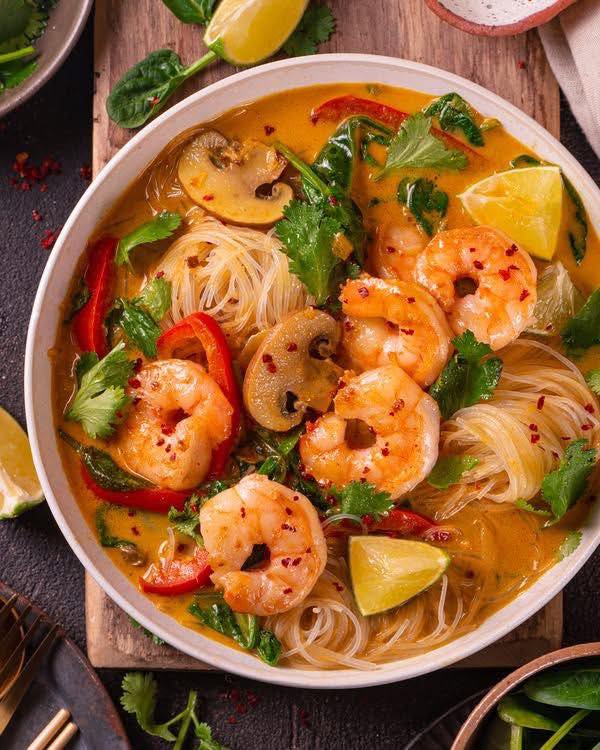ADVERTISEMENT
## **The Origins of Thai Coconut Shrimp Noodle Soup**
Thai cuisine is known for its bold, harmonious combinations of sweet, salty, sour, and spicy flavors. Coconut milk plays a key role in many Thai dishes, providing richness and creaminess while balancing out the heat from chilies and spices. **Thai Coconut Shrimp Noodle Soup** is a perfect example of how these elements come together to create a comforting yet exciting meal.
Coconut-based soups, such as the famous **Tom Kha Gai** (a coconut chicken soup) and **Tom Yum Goong** (a spicy shrimp soup), are staples of Thai cuisine. The Thai Coconut Shrimp Noodle Soup is a variation of these beloved soups, with the addition of noodles to make it a more substantial dish.
The beauty of Thai food lies in its ability to use fresh, fragrant ingredients such as lemongrass, kaffir lime leaves, fish sauce, and chilies. These ingredients are the building blocks of many Thai soups, contributing to the distinctive flavors that define Thai cuisine. When paired with shrimp, one of Thailand’s most popular seafoods, and coconut milk, the result is a comforting bowl of soup that is both soothing and refreshing.
—
## **Ingredients for Thai Coconut Shrimp Noodle Soup**
The key to a delicious **Thai Coconut Shrimp Noodle Soup** lies in the quality and balance of the ingredients. While some ingredients may seem exotic, they can often be found at your local grocery store or Asian market. Here is a list of the ingredients you’ll need:
### **For the Soup Base:**
– **1 tablespoon vegetable oil**: Used for sautéing the aromatics and creating the base of the soup.
– **1 tablespoon ginger** (fresh, finely chopped): Provides a fresh and spicy note to the soup.
– **2 cloves garlic** (minced): A classic flavor enhancer that adds depth to the soup.
– **1 tablespoon red curry paste**: The heart of the flavor in this soup, red curry paste is made from a blend of chilies, garlic, ginger, and spices. It imparts a mild heat and a rich, complex flavor.
– **2 stalks lemongrass** (smashed and cut into 3-inch pieces): Lemongrass is a fragrant herb used in Thai cuisine to infuse soups with a citrusy, refreshing aroma.
– **3 kaffir lime leaves**: These leaves provide a distinct lime fragrance that complements the coconut milk and adds an authentic Thai flavor.
– **1 can (14 oz) coconut milk**: The creamy base of the soup, coconut milk adds richness and smoothness to the broth.
– **3 cups chicken or vegetable broth**: The liquid component that adds depth to the soup. Chicken broth is commonly used, but vegetable broth is a great option for a lighter or vegetarian version.
– **2 tablespoons fish sauce**: A staple in Thai cooking, fish sauce adds a salty, umami flavor that enhances the overall profile of the soup.
– **1 tablespoon brown sugar**: Balances out the savory and sour notes, creating a harmonious flavor.
– **1 tablespoon lime juice**: Adds a tangy brightness to the soup and balances the richness of the coconut milk.
– **1-2 Thai bird’s eye chilies** (optional, minced): If you like your soup spicy, adding these fiery chilies will elevate the heat.
### **For the Shrimp and Noodles:**
– **1 lb large shrimp** (peeled and deveined): Shrimp is the star protein of the soup, adding a succulent, tender bite to each spoonful.
– **6 oz rice noodles** (or any noodle of choice): Rice noodles are commonly used in Thai soups and have a delicate texture that absorbs the flavors of the broth.
### **For Garnishing:**
– **Fresh cilantro** (chopped): Adds a fresh, herbaceous note to the soup.
– **Thai basil** (optional): Thai basil has a slightly spicy and peppery flavor, which pairs wonderfully with the coconut broth.
– **Lime wedges**: For an extra burst of citrus right before serving.
– **Chili flakes or chili oil** (optional): For those who enjoy extra heat.
– **Thinly sliced red onions or shallots** (optional): For an additional layer of flavor and crunch.
– **Sliced mushrooms** (optional): Mushrooms can be added for a meaty texture and extra umami flavor.
For Complete Cooking STEPS Please Head On Over To Next Page Or Open button (>) and don’t forget to SHARE with your Facebook friends
